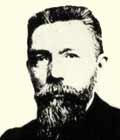
Baudot, Jean-Maurice-Émile (1845 - 1903)
Baudot was born on 11 September 1845 in Magneux, France.
Baudot was a lieutenant in the French telegraph service. He worked on a mechanical system capable of automatically translating the Latin alphabet into Morse code, and vice versa. However, the dot-and-dash Morse code system complicated this task. Morse is a code in which each character that is to be sent is composed of a number of signals. This number may be unlike the number of signals forming any other character. Physically, these signals are not of the same length (“dots” and “dashes”). Telegraph engineers had long concluded that it was too difficult a task to manufacture a machine that would manage this system as such, and the real solution was to change the coding system.
They were working on a method in which all characters were composed of the same number of signals and all signals were of the same length. This way, it took just as long to transmit any character. Nowadays, this method of transmitting information is known as time division multiplexing or TDM. This was how five-element codes were developed, in which each element has two states (our modern “bits”). Five elements in base 2 are able to code 32 states, more than enough for the whole alphabet. But 32 states are not sufficient to represent all the letters, numbers and common punctuation marks. Therefore, they created two character lists and reserved two of the 32 possible states for control purposes. One of these control states served the purpose of announcing that henceforth the characters were to be translated with the other list. The other control state indicated the end of the use of the extended list and the return to the primary translation list. This made 60 possible characters available. Typewriters and computer keyboards apply the same idea, implemented by the “shift” key.
Bhis was Baudot’s starting point. Exploiting the ideas of the Hughes telegraph machine, a multiplexing system for ordinary Morse machines developed by Bernard Meyer in 1871 and a five bit code created by Johann Gauss and Wilhelm Weber, he managed to manufacture a machine that successfully solved the alphabet translation problem in 1874. The Baudot distributor was capable of multiplexing and simultaneously transmitting the five signals over a single line and printing the signals as clear text at the receiving station. It reached a speed of over 180 characters per minute. The Baudot telegraph operator had a piano-like keyboard with just five keys.
Telegraphists pressed combinations of these five keys to encode the character that they wanted to send according to the Baudot machine alphabet. Several keyboards could be connected to a single distributor, which then sent a joint signal from all keyboards along an electric cable. Another distributor was connected at the other end of the line to multiple printers which printed the letters, numbers and marks on slips of paper that were then cut and pasted on the telegram.
The CCITT (“Comité Consultatif International Téléphonique et télégraphique”) standardized the original Baudot machine code as “International Telegraph Alphabet No. 1” or ITA1. ITA1 is now obsolete.
In 1901, a New Zealand farmer named Donald Murray designed a new telegraph machine for which purpose he modified the Baudot code. This new code, with start and stop characters compatible with the new asynchronous machines of the time, was standardized by the CCITT in 1930 as International Telegraph Alphabet No. 2 or ITA2. It is popularly known as Baudot-Murray code and is still in use today.
The unit that identifies the number of samples or changes of state of the carrier signal that can be sent per second is known as baud in honour of Émile Baudot. If each of these changes supports only two states, the number of bauds is equal to the bits sent per second. However, if the domain of the sample states is greater than two, the number of bits per second sent and the number of bauds no longer match.
ASCII code (American Standard Code for Information Interchange) was to use the primitive Baudot code concept as a 7-bit table encoding 128 symbols, including letters, numbers and several punctuation marks. Later, the extended 8-bit ASCII code was developed, which encoded 256 symbols and is widely used in computing.
Baudot died on 28 March1903 in Sceaux, near Paris.
